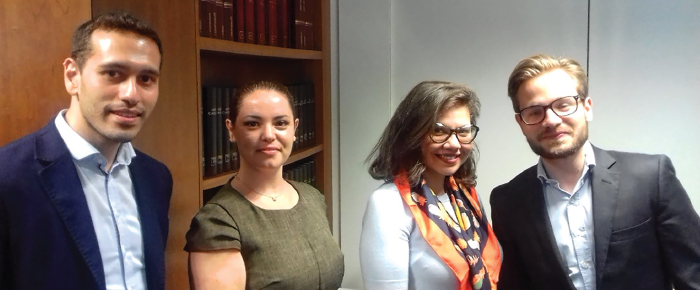
Virtual currencies are revolutionary because money now no longer depends on a government’s central bank. For years, banknotes and coins were produced by central institutions and backed on real assets (such as gold), allowing nations to control the destiny of their finances.
For centuries, politics adapted to economics, creating liberal systems. On the other side, political ideologies forced the economy to follow the path they had designed and in doing so created strongly centralized states. In the first case, economics shaped politics and in the second, politics shaped economics. However, experience says that economics and politics have always walked side-by-side.
The virtual economy finds this system antiquated and has claimed its independence from these dusty patterns. A virtual economy produces virtual currencies—formless creatures born in the wake of the 2008 financial crisis. This new money possesses no material form and is administrated by blockchains (i.e., a kind of “electronic general ledger” if reverting to old concepts). No central entity controls their value or supply; the units are created by “miners,” that is to say internet users, who have installed software on their computers, and have created an algorithm. Bitcoin is the most popular, but more than one thousand cryptocurrencies1 are currently alive and kicking.
Behind all of this lurks cryptography. Cryptography “collaborates to keep secrets in a world of prying eyes. A sender attempts this by transforming a private message to an altered state, a sort of mystery language: encryption.2 Once the message is transformed into a cacophonous babble, potential eavesdroppers are foiled. Only those in possession of the rules of transformation can restore the disorder back to the harmony of the message as it was first inscribed: decryption.”3 In other words, if one wants to penetrate the cryptoworld and restore harmony, one needs a key4 (actually two keys: a private and a public key).
And regulators who cannot find the keys are left at the doorstep.
To regulator or not to regulate? That Is the Question
Virtual currencies and the brand new financial infrastructure does not fit into the economic plans conceptualized by people of the same mindset found in traditional governmental treasury or finance departments. Instead, blockchain calculates, computes and assembles bits with bits and aggregates digital signatures. It drives on the digital highways it has mechanically built.
On a macro-international level, no overall regulation for virtual currencies exists at the moment. The whole blockchain (general ledger) infrastructure knows no borders by nature and each country seems to have its own view concerning the relevance of regulation or even the mere concept’s definitions. The G-20 wanted to have this subject on its agenda in 2018 but no formal decision was made. “One reason for the G20’s inaction is that they see cryptocurrencies as too small to jeopardize financial markets. Their combined market value was, at its peak, less than 1 percent of the world’s economy,” said Chair of the Financial Stability Board Mark Carney.5 Nevertheless, the G-20 invited new standards to be proposed by the Financial Action Task Force (FATF) that could lead to mitigating the risks of money laundering, terrorist financing and tax evasion,6 which are inherent to these products.
In Europe, the Fifth AML Directive, adopted in April 2018, requires virtual money providers to comply with anti-money laundering (AML) requirements. The French monetary code 7 echoes these provisions.
Identification Is at the Root of AML/CTF Compliance Programs
Customer identification is at the root of the FATF Recommendations. One of the main characteristics of the official banking system is that it must identify its customers in order for the financial industry and the authorities in charge to track fund transfers. The unofficial money transfer system called “hawala” is a good example of what authorities absolutely want to avoid. In this underground system, funds travel without being tracked. On one hand, the official traditional money transfer system will trace any transaction and comply with all the applicable legal requirements (identification, thresholds, reporting suspicious activities, etc.). On the other hand, the unofficial system will transfer funds in the same way but remain covert. Virtual currency activities, in many places of the world, take place at this stage in what can be compared to a global underground financial system.
The traditional identification system is also based on names. The virtual currency system liberates itself from this tradition. Even though virtual currencies leave a trace, 8 every time they are the objects of a transformation (sold, bought, exported, imported, etc.), determining who is behind the trace is a real challenge. “Transactions are identified by the bitcoin address—[a] string of letters and numbers—that is not systematically linked to an individual.”9 Regulators will need to find new ways to identify individuals while adjusting to the new reality that human beings that used to be identified by their last and forenames based on ID documents are now being reduced to a mere chain of digital signatures spreading furtively from one machine to another. The cultural gap between these two approaches is huge for regulators! Let alone for everyone else.
Four Students Present An AML/CTF Bitcoin Platform Risk Assessment
Bitcoin has its followers, mainly young people and their naysayers, mainly older people. They even have their fanatics, considered to be “anarchists of the new age”10 (who spread a flair of revolution and certainly highlight some obvious flaws inherent to our contemporary world).
In June 2018, four students working toward compliance officer university degrees, developed by the University of Versailles and ACAMS,11 presented their year-end work. They developed a risk-matrix for a virtual currency platform based in France. The entity they developed supposedly offered the purchase and the sale of bitcoins against traditional currencies as well as their storage, their exchange and an Initial Coin Offering service (ICO).12 The students were enthusiastic and strongly convinced that digital money had a bright future.
During their presentation, they reflected on the way this toddler could be integrated into an already mature regulatory framework. A “mature anti-money laundering/counter-terrorist financing (AML/CTF) infrastructure” is an infrastructure that has been rolling rather well for the past few years, that applies to a growing number of industries and is the result of the concerted efforts of FATF and the legislations of its members (with an extra layer for European countries: the AML Directives).
The students briefly summarized the main characteristics of a magic coin they created and defined it as “over layers of the IP protocol.”13 They suggested that the newbies might not be that revolutionary after all, at least from a technological point of view.
They explained how the compliance AML/CTF program they imagined for the purpose of their final exam could mitigate the risk pertaining to these new products. In accordance with the law in force, they proposed to identify and monitor their customers in the same way customers of traditional products would be identified. Existing regulation forces them to comply with the whole set of rules pertaining to a regulated party, including customer due diligence, enhanced due diligence triggered by a specific customer profile and/or thresholds,14 controls on the beneficial owners, monitoring of politically exposed persons, screening on terrorist lists, object of the business relationship, nature of the activity, residency of the customer—in the view of monitoring the Foreign Account Tax Compliance Act risk, record keeping, suspicious activity reports, blacklisted countries, etc.
The good old identification method is therefore applied to the newcomer.
Flip Sides of Bitcoin
Within the frame of their year-end presentation, the students identified further risks inherent to virtual currencies for their enterprise including the following:
- Bitcoin makes it possible to buy and sell illicit products (drugs, weapons, counterfeited goods) without being detected. The dark web or “shadow” internet therefore offers a good opportunity to spend bitcoin behind the curtain and access products that are unavailable on the open web. Virtual currency providers will have to ensure that the object of the business relationship with their customer is clearly specified. What if a customer buys weapons to perpetrate a terrorist act? Would the platform be held responsible?
- Bitcoin is far from being stable. The value of virtual currencies is subject to fluctuation and highly speculative—the same good old mechanism in force with securities: “Buy and sell big quantities of bitcoins, make money and as a side effect see prices fluctuate” applies to Bitcoin. Bitcoin is worth the demand it generates; its value is measured by market supply and demand (hence, its floating exchange rate). This potential instability is a commercial risk for the currency provider.
Further higher-level risks detected include the following:
- The 51 percent ownership rule moderates the attractiveness of Bitcoin. At any time, anyone with enough electricity and power could in theory become an administrator and take control of the “general ledger.” The once decentralized ledger would then be centralized and anyone with 51 percent ownership would gain enough authority to withdraw the ledger from circulation (among other possibilities).
- Bitcoin is not green. Bitcoin is generated by computers solving complex mathematical problems. These operations require a large quantity of electricity and electricity is expensive for the planet and for the wallets (“The computer power needed to create each digital token consumes at least as much electricity as the average American household burns through in two years”).15
- Pickpockets do not only exist in the subway; virtual currencies can be stolen or hacked online more easily than traditional currencies.
- During World War II, the Third Reich tried to subdue the British economy by generating false banknotes. They tried to flood the U.K. with false currencies in order to diminish the trust placed by the British population in its money and in order to cause hyperinflation. Would virtual currencies not be in the same position should they be developed to have the same impact? Would they affect the traditional economic structure in the same way? Would they not compete with legal currencies? This risk is probably too high to have any impact on the students’ structure.
Should You Absolutely Want to Find Something Good About Bitcoin
- Virtual currencies exist and they will probably develop and transform. Just as prehistoric men could not forget about the advantages of fire once fire was discovered, human beings will not be able to make it without technology in the future. It makes life easier and humans now have the knowledge to produce this technology. Technology is not good or bad intrinsically; it is merely a symptom of scientific progress.
- Crypto assets can improve payment efficiency and reduce transaction costs for payments and fund transfers. The lack of exchange fees and lower commissions for credit cards issuers and banks could be an advantage for customers and companies. They can reduce their dependence to the banking sector in general.
- Companies can take advantage of Bitcoin by fostering customer loyalty and motivating them to spend their virtual money on their products rather than on their competitors’ products.
- Cryptography makes it possible to escape from over-connection and regain some privacy. Bitcoin enables selling and buying goods with no spy around.16
- Emerging countries might make use of Bitcoin. In developed countries, most citizens rely on a bank account and can access a full range of banking services. This is not the case in some emerging countries whose populations are under-banked or even unbanked. Bitcoin may allow people to benefit from a reliable, stable means of payment in parts of the world where acquiring goods is difficult because of monetary instability. Idealism does not always rhyme with realism. Nevertheless, if emerging countries can find a way to better their economic situation and access consuming goods, thanks to alternative means of payment, this possibility should be given serious consideration.

Regulator, Please Regulate
The years 2008 and 2018: are these two dates pure coincidence? Years ending with an “8” are reputed to be years of financial crisis. Bitcoin was created in the aftermath of the 2008 financial crisis that was, if we want to grossly summarize the situation, generated by non-regulated products or at least by the part of the economy that was not regulated enough. The non-regulated products seemed to have derived or shifted far too much from the real world and were no longer backed with any real or physical assets—or at least had lost their initial link to their underlying assets a long time ago. This created a bubble; the bubble exploded.
Does this sound familiar? Bitcoin was created in the hope to offer an alternative to derivatives and to the traditional financial system but shares the same flaws and the same risks as junk products: the risk of landing and evolving in a parallel economy.
The following political statement concerning the dark web confirms that the way crypto finance intertwines with politics is somewhat worrying: “BlackNet also is purported to deal in money, offering to make anonymous deposits in the bank of your choice. You could deal with BlackNet using actual cash or ‘cryptocredits.’ BlackNet’s own internal currency (which could be used in any sort of untraceable clandestine information transaction you chose). And BlackNet itself had no ideology of its own save one: ‘We consider nation-states, export laws, patent laws, national security considerations, and the like to be relics of the pre-cyberspace era.’”17
For the dark web, regulators are relics. It cannot be denied that it is extremely difficult for law enforcement to target one decentralized location or entity, to investigate a case, to seize assets or even to identify an individual in this digital world. Nevertheless, law enforcement has made numerous efforts to fight money laundering and terrorist financing in the recent years and now faces the challenge of apprehending the digital newcomer. The FBI has been in the position to arrest individuals who have used bitcoin on the dark web thanks to the analysis of the corresponding blockchain. In another instance, the French financial intelligence unit in a report explained how they discovered a fraud scheme thanks to the analysis of a blockchain.18 This means that regulations can help mitigate the risks of virtual currencies and that regulators have started to adapt to this new situation.
Bitcoin gives regulators a major role to play and presents challenges. Too much regulation surely kills business and free enterprise. But a lack of regulation may put society and democracy at stake in the long run. Virtual currencies offer the possibility to rethink the link between finance, regulation and society. Develop them—is there any choice anyway?—but not out of the regulatory framework box. The lack of regulation has never been a warrant for a better world. Hopefully, security expert Donn Parker is wrong when he says: “With the power of crypto, we have the capability of 100 percent privacy. But if we use this, I don’t think society can survive.”19 The regulatory answer seems to be the only viable answer. This proposition might sound very conservative, but is there any other choice?
Acknowledgement: This article was mainly based on the work and analysis delivered by the four students mentioned above. Most of the sources and research quoted are a result of the fruits of their labor. The France Chapter wishes to thank them for their points of view on this very exciting subject.
To learn more about how to understand virtual currencies and Blockchain technology and how to mitigate the risks, please visit: http://www.acams.org/virtual-currency-and-blockchain-training/.
- “L’émergence du bitcoin et autres crypto-actifs: enjeux, risques et perspectives,” Banque de France, March 5, 2018, https://publications.banque-france.fr/sites/default/files/medias/documents/focus-16_2018_03_05_fr.pdf
- Encryption: The act of scrambling information (into cyphertext) so that intercepted messages cannot be read.
- Steven Levy, “Crypto, How the Code Rebels Beat the Government-Saving Privacy in the Digital Age,” Viking, Penguin Books, 2001.
- Key: The component of a crypto system that determines how the message will be scrambled. A key applied to a plain text message becomes cyphertext (definition extracted from Crypto, How the Code Rebels Beat the Government-Saving Privacy in the Digital Age).
- Francesco Canepa,“G20 agrees to ‘monitor’ cryptocurrencies but no action yet,” Reuters, March 20, 2018, https://www.reuters.com/article/us-g20-argentina-bitcoin/g20-agrees-to-monitor-cryptocurrencies-but-no-action-yet-idUSKBN1GW2R9
- “Bitcoin : le G20 Finances refuse de le considérer comme une monnaie” La Tribune, March 21, 2018, https://www.latribune.fr/economie/international/bitcoin-le-g20-finances-refuse-de-le-considérer-comme -une-monnaie-772554.html
- Article L.561-2, 7° bis of the French Monetary Code. According to the Banque de France, virtual currencies or crypto assets are “any instrument containing non-monetary units under a digital form that can be stored or be transferred in order to buy goods or services but that do not constitute a claim on the issuer.”
- Digital signature: Mathematically generated cryptographic data that undeniably identify a message with its sender.
- “Virtual Currencies: Key Definitions and Potential AML/CFT Risks,” Financial Action Task Force, June 2014, http://www.fatf-gafi.org/media/fatf/documents/reports/Virtual-currency-key-definitions-and-potential-aml-cft-risks.pdf
- Edward Snowden is one of the most famous crypto anarchists.
- The Compliance Officer University Degree is proposed by the University of Versailles and ACAMS: http://www.uvsq.fr/du-compliance-officer-specialite-lutte-anti-blanchiment-375904.kjsp
- An Initial Coin Offering, also commonly referred to as an ICO, is a fundraising mechanism in which new projects sell their underlying crypto tokens in exchange for bitcoin and ether. It is somewhat similar to an Initial Public Offering (IPO) in which investors purchase shares of a company: https://bitcoinmagazine.com/guides/what-ico/
- “Virtual Currencies: Key Definitions and Potential AML/CFT Risks,” Financial Action Task Force, June 2014, http://www.fatf-gafi.org/media/fatf/documents/reports/Virtual-currency-key-definitions-and-potential-aml-cft-risks.pdf
- The average bitcoin transaction amounts to 550 euros: https://www.crypto-france.com/bitcoin-chiffres-statistiques
- Nathaniel Popper, “There Is Nothing Virtual About Bitcoin’s Energy Appetite,” The New York Times, January 21, 2018, https://www.nytimes.com/2018/01/21/technology/bitcoin-mining-energy-consumption.html
- William Davidow, “Overconnected: The Promise and Threat of the Internet,” Delphinium, 2011.
- Steven Levy, “Crypto, How the Code Rebels Beat the Government-Saving Privacy in the Digital Age,” Viking, Penguin Books, 2001, p. 224.
- “Tendances et analyse des risques de blanchiment de capitaux et de financement du terrorisme en 2016,” Tracfin, 2016, https://www.economie.gouv.fr/files/rapport-analyse-tracfin-2016.pdf
- Steven Levy, “Crypto, How the Code Rebels Beat the Government-Saving Privacy in the Digital Age,” Viking, Penguin Books, 2001, p. 225.










